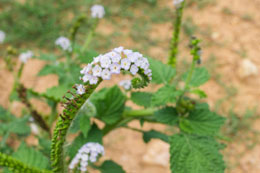The heliotrope plant is cherished for its highly-fragrant flowers, that appear in clusters during midsummer. This remarkable plant is known for its tendency to turn its leaves towards the sun. Discover more about this flowering plant, and how to care for it, through this Buzzle article.

The plants of the genus
Heliotropium are commonly known as heliotropes. The genus
Heliotropium contains approximately 250 to 300 species of flowering plants, that belong to the plant family,
Boraginaceae.
The name heliotrope is derived from two Greek words,
helios, which means sun and
tropein, which means 'to turn'. The plant got this name due to the fact that it has the tendency to turn its leaves towards the sun during the entire day. At night, the plant readjusts towards the east so as to be ready for the sunshine. Due to this peculiar inclination, this plant is also known by the name of 'turnsole'.
Plant Description
These are small plants that reach a height of about 12 to 36 inches. Their leaves are usually broad, crinkled, and dark green in color. The flowers appear in clusters, and they can be deep purple, white, or blue in color. However, purple flowers are more common, and they are also more fragrant than the white and the blue blossoms.
The heliotrope blossoms are one of the most fragrant flowers to be around. Their fragrance is compared to the smell of cherry pie, for which this plant is also known by the name of 'cherry pie plant'. The highly aromatic flowers of the 'turnsole' plant bloom in the midsummer. The flowers appear in clusters to form a single flower head on each stem.
Plant Care
The most crucial factors that determine the growth of these flowering plants are the amount of water and sunlight they receive. These plants prefer bright sunlight, but appreciate some shelter in the late afternoon, as intense sunlight in the late afternoon can burn their leaves.
Next to sunlight, heliotropes prefer rich and moist soil. However, the soil should not be wet. So, water them adequately to keep the soil moist, but avoid over-watering. At the same time, do not let the soil dry out completely. Ideally, these plants should be grown in well-drained soil. You can apply a layer of mulch around the plants, in order to keep the soil moist. Usually, thorough watering once in a week is sufficient for ensuring their proper growth. However, you have to increase the frequency of watering during the dry season.
For ensuring better growth, you can apply fertilizers thrice a year. The ideal time for fertilization is mid summer, late spring, and early fall. You can use a slow-release, water-soluble fertilizer for this purpose. Along with fertilization, pinching is very important for stimulating the growth of these plants. So, pinch off the tip of the plants in order to maintain a bushy appearance.
Be sure to remove the blooms, once they have faded. This is known as deadheading, and it helps promote better blooming during the entire season. In frost-prone areas, do not forget to bring the container-grown heliotropes indoor before the first frost of winter.
If grown properly, this plant can be a fragrant addition to your garden. It can look really beautiful with other small garden plants like orange marigold and pink or white begonias.






 The plants of the genus Heliotropium are commonly known as heliotropes. The genus Heliotropium contains approximately 250 to 300 species of flowering plants, that belong to the plant family, Boraginaceae.
The plants of the genus Heliotropium are commonly known as heliotropes. The genus Heliotropium contains approximately 250 to 300 species of flowering plants, that belong to the plant family, Boraginaceae.